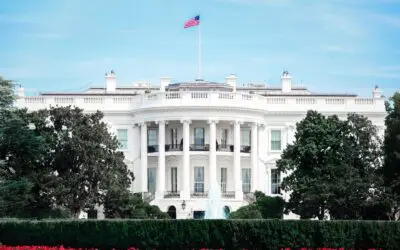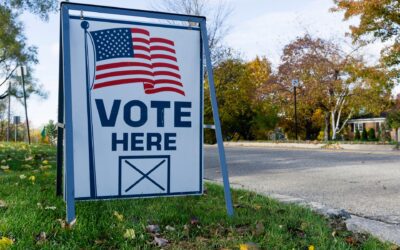With GDP growth having finally returned, but unemployment still rising slowly toward 10 percent, the economy is at a sensitive juncture as an issue for the 2010 elections. Almost half of voters in the 60 most competitive Democratic and Republican congressional districts now rate their personal finances positively and half believe the economic recovery plan passed by Congress and signed by the president will have a positive impact. Yet, only 16 percent have a positive view of the current economy and only a third think the economy is “starting” to improve. Independents are particularly pessimistic on economic issues, with important consequences for the midterm elections.
That half in these swing (but Republican-leaning) districts believe that President Obama’s economic recovery plan could help suggests the economy could break in favor of Democrats, but the country is not ready to listen to a narrative about how Democrats have brought the economy “back from the brink” and averted an even worse disaster, as articulated by the president in his joint session address to Congress earlier this year. That leaves a lot of receptivity to Republican messages that focus on wasted spending and exploding deficits. On the other hand, focusing on the specific benefits in the stimulus package that have helped working Americans through the crisis and on rebalancing the economy so it works for the middle class (not just the wealthy) has a much bigger impact and effectively challenges the Republican narrative.
These results are based on a new survey by Democracy Corps and Greenberg Quinlan Rosner Research across the 60 most marginal congressional districts (40 Democratic-controlled and 20 Republican-held).[1]
The Dangers of Taking Premature Credit for Economic Turnaround
With the specter of a second Great Depression behind us, our economy growing again, the Dow having briefly cracked 10,000 and some TARP recipients repaying their loans, some Democrats have begun tentatively taking credit for the beginning of an economic turnaround. While voters think that could eventually be true, they are far from entertaining the idea that the economy is fundamentally improving, at least in any way that they can feel. They may well punish politicians who get ahead of themselves, look out of touch and, more important, fail to talk about the on-going help from the recovery package that counters the Republican interpretation about spending.

Almost half of voters across this battleground have a positive feeling about their own personal finances (48 percent, against just 27 percent who have a negative feeling). And nearly half (46 percent) say that Obama’s economic recovery plan has or will have a positive impact on the economy. This is not a bad result in this Republican-leaning battleground, considering that unemployment is approaching 10 percent.

However, voters clearly do not think that the economy has yet turned the corner. Nearly 7-in-10 rate the “state of the economy” unfavorably, with 43 percent holding a very unfavorable view. Moreover, just a third, or so, of voters in the battleground believe the economy has already turned a corner and is “starting to improve.”
Independents are, of course, a key battleground for 2010, and their feelings regarding the economy could be problematic for Democrats. Interestingly, feelings about one’s personal finances are not correlated with partisan identification, but feelings about the state of the economy are strongly correlated, with Democrats much more optimistic. Half of Democrats say the economy is “starting to improve,” but only a quarter of independents and a fifth of Republicans agree.
While 56 percent in the congressional battleground still say that President Obama and the Democrats are “mainly dealing with problems inherited” from Bush (and only 38 percent, “problems of their own creation”), a lot of concern and skepticism remain about the risks of the current course. These voters are split (46 to 49 percent) on whether Obama’s policies have helped avert a worse crisis and laid the foundation for an economic recovery, or whether they have simply run up the deficit while failing to slow job losses. And more troublesome for Democrats, only about a third of independents in the Democratic-held districts say that Obama’s policies have helped avert a crisis while laying a foundation for recovery.
Top Messages Center on Benefits for Middle Class
Considering these results, it is not surprising that a message taking credit for “bold and decisive action” that “pulled this economy back from the brink” fell completely flat with these voters. Across the entire congressional battleground, just 43 percent of voters found this argument convincing, easily the lowest of six Democratic economic messages tested. The timing for such a message is clearly way off – and leaves the voters to hear Republican interpretations of the economy that, at this juncture, are much more in touch with the reality voters are feeling.
Though none of the Democratic messages broke through strongly, the two that tested the best are centered on the tangible benefits (unemployment insurance, tax cuts and preventing police and teachers from losing their jobs) in the stimulus package that helped working families get through the crisis, and on the need to rebalance the economy to ensure it works for the middle class as we emerge from this recession.
Meanwhile, Republican messages on the economy were slightly stronger overall, generated more intensity and were significantly more potent with independents voters. The strongest Republican message centered on a straight spending argument, claiming that Democrats had approved 5 trillion dollars in new spending, added to the deficit and left a “mountain of debt” for our grandchildren to pay back. This message was convincing to 58 percent of voters (very convincing to 32 percent) and was actually slightly stronger than a message that tied spending to increasing unemployment.[2]
| Appendix A: Districts by Tiers |
| TIER 1 DEMOCRATIC DISTRICTS | |||||
| STATE AND DISTRICT | DEMOCRATICINCUMBENT | INCUMBENT SINCE | 2008 CONG. MARGIN | 2006 CONG. MARGIN | 2008 PRES. MARGIN |
| ALABAMA 02* | Bobby Bright | 2008 | Dem. +1 | Rep. +39 | McCain +26 |
| ALABAMA 05* | Parker Griffith | 2008 | Dem. +4 | No Rep. | McCain +23 |
| COLORADO 04* | Betsy Markey | 2008 | Dem. +12 | Rep. +3 | McCain +1 |
| FLORIDA 08* | Alan Grayson | 2008 | Dem. +4 | Rep. +7 | Obama +6 |
| FLORIDA 24* | Suzanne Kosmas | 2008 | Dem. +16 | Rep. +16 | McCain +2 |
| IDAHO 01* | Walt Minnick | 2008 | Dem. +1 | Rep. +5 | McCain +26 |
| LOUISIANA 03 | n/a | n/a | Unopposed | Dem. +15 | McCain +25 |
| MARYLAND 01* | Frank Kratovil | 2008 | Dem. +1 | Rep. +38 | McCain +18 |
| MISSISSIPPI 01* | Travis Childers | 2008 | Dem. +11 | Rep. +32 | McCain +25 |
| NEW HAMPSHIRE 01* | Carol Shea-Porter | 2006 | Dem. +6 | Dem. +2 | Obama +6 |
| NEW HAMPSHIRE 02* | n/a | n/a | Dem. +15 | Dem. +7 | Obama +13 |
| NEW JERSEY 03* | John Adler | 2008 | Dem. +4 | Rep. +17 | Obama +5 |
| NEW MEXICO 02* | Harry Teague | 2008 | Dem. +12 | Rep. +19 | McCain +1 |
| NEW YORK 24* | Mike Arcuri | 2006 | Dem. +4 | Dem. +9 | Obama +2 |
| NEW YORK 29* | Eric Massa | 2008 | Dem. +2 | Rep. +2 | McCain +2 |
| OHIO 01* | Steve Driehaus | 2008 | Dem. +5 | Rep. +4 | Obama +10 |
| OHIO 15* | Mary Jo Kilroy | 2008 | Dem. +1 | Rep. +0.5 | Obama +9 |
| PENNSYLVANIA 03* | Kathy Dahlkemper | 2008 | Dem. +2 | Rep. +12 | McCain +0.01 |
| VIRGINIA 02* | Glenn Nye | 2008 | Dem. +5 | Rep. +3 | Obama +2 |
| VIRGINIA 05* | Tom Perriello | 2008 | Dem. +0.2 | Rep. +19 | McCain +2 |
| TOTAL TIER 1 DEMOCRATIC DISTRICTS: | DEM. +6 | REP. +6 | McCain +5 | ||
| Margins calculated by “Democratic Vote – Republican Vote.” In ‘Unopposed’ districts, no Republican candidate ran.NOTE: Starred districts have time series data from previous waves of Democracy Corps research in the congressional battleground this year. Time series data points reflect data only from these districts. |
| TIER 2 DEMOCRATIC DISTRICTS | |||||
| STATE AND DISTRICT | DEMOCRATICINCUMBENT | INCUMBENT SINCE | 2008 CONG. MARGIN | 2006 CONG. MARGIN | 2008 PRES. MARGIN |
| ARIZONA 01* | Ann Kirkpatrick | 2008 | Dem. +16 | Rep. +9 | McCain +10 |
| ARIZONA 05* | Harry Mitchell | 2006 | Dem. +10 | Dem. +4 | McCain +5 |
| CALIFORNIA 11* | Jerry McNerney | 2006 | Dem. +11 | Dem. +6 | Obama +9 |
| GEORGIA 08* | Jim Marshall | 2002 | Dem. +14 | Dem. +2 | McCain +13 |
| ILLINOIS 11* | Debbie Halvorson | 2008 | Dem. +24 | Rep. +10 | Obama +8 |
| ILLINOIS 14* | Bill Foster | 2008 | Dem. +16 | Rep. +20 | Obama +11 |
| INDIANA 09* | Baron Hill | 2006 | Dem. +19 | Dem. +5 | McCain +1 |
| MICHIGAN 07* | Mark Schauer | 2008 | Dem. +2 | Rep. +4 | Obama +6 |
| MICHIGAN 09* | Gary Peters | 2008 | Dem. +9 | Rep. +6 | Obama +13 |
| NEVADA 03* | Dina Titus | 2008 | Dem. +5 | Rep. +1 | Obama +13 |
| NEW MEXICO 01* | Martin Heinrich | 2008 | Dem. +11 | Rep. +0.4 | Obama +20 |
| NEW YORK 13* | Mike McMahon | 2008 | Dem. +27 | Rep. +14 | McCain +2 |
| NEW YORK 19 | John Hall | 2006 | Dem. +17 | Dem. +2 | Obama +2 |
| NEW YORK 20* | Scott Murphy | 2009 | Dem. +0.5 | Dem. +6 | Obama +3 |
| NORTH CAROLINA 08* | Larry Kissell | 2008 | Dem. +11 | Rep. +0.3 | Obama +6 |
| OHIO 16* | John Boccieri | 2008 | Dem. +11 | Rep. +16 | McCain +3 |
| PENNSYLVANIA 07 | n/a | n/a | Dem. +19 | Dem. +13 | Obama +13 |
| TEXAS 17* | Chet Edwards | 1990 | Dem. +7 | Dem. +18 | McCain +35 |
| TEXAS 23* | Ciro Rodriguez | 2006 | Dem. +14 | Dem. +8 | Obama +3 |
| WISCONSIN 08* | Steve Kagen | 2006 | Dem. +8 | Dem. +2 | Obama +8 |
| TOTAL TIER 2 DEMOCRATIC DISTRICTS: | DEM. +13 | REP. +1 | Obama +3 | ||
| Margins calculated by “Democratic Vote – Republican Vote.” In ‘Unopposed’ districts, no Republican candidate ran.NOTE: Starred districts have time series data from previous waves of Democracy Corps research in the congressional battleground this year. Time series data points reflect data only from these districts. |
| MOST COMPETITIVE REPUBLICAN DISTRICTS | |||||
| STATE AND DISTRICT | REPUBLICANINCUMBENT | INCUMBENT SINCE | 2008 CONG. MARGIN | 2006 CONG. MARGIN | 2008 PRES. MARGIN |
| CALIFORNIA 03* | Dan Lungren | 2004 | Rep. +5 | Rep. +21 | Obama +0.5 |
| CALIFORNIA 44* | Ken Calvert | 1992 | Rep. +2 | Rep. +23 | Obama +1 |
| CALIFORNIA 45* | Mary Bono Mack | 1998 | Rep. +17 | Rep. +22 | Obama +5 |
| CALIFORNIA 50* | Brian Bilbray | 1994 | Rep. +5 | Rep. +10 | Obama +4 |
| DELAWARE AL* | n/a | n/a | Rep. +23 | Rep. +18 | Obama +25 |
| FLORIDA 10* | Bill Young | 1970 | Rep. +21 | Rep. +32 | Obama +4 |
| FLORIDA 12* | n/a | n/a | Rep. +15 | Rep. +50 | McCain +4 |
| ILLINOIS 10* | n/a | n/a | Rep. +5 | Rep. +6 | Obama +23 |
| LOUISIANA 02* | Joseph Cao | 2008 | Rep. +3 | Dem. +14 | Obama +49 |
| MICHIGAN 11* | Thad McCotter | 2002 | Rep. +6 | Rep. +11 | Obama +9 |
| MINNESOTA 03* | Erik Paulsen | 2008 | Rep. +8 | Rep. +30 | Obama +6 |
| MINNESOTA 06* | Michele Bachmann | 2006 | Rep. +3 | Rep. +8 | McCain +9 |
| MISSOURI 09* | Blaine Luetkemeyer | 2008 | Rep. +2 | Rep. +25 | McCain +11 |
| NEBRASKA 02* | Lee Terry | 1998 | Rep. +5 | Rep. +10 | Obama +1 |
| OHIO 02 | Jean Schmidt | 2005 | Rep. +7 | Rep. +1 | McCain +20 |
| OHIO 12* | Patrick Tiberi | 2000 | Rep. +13 | Rep. +14 | Obama +7 |
| PENNSYLVANIA 06* | n/a | n/a | Rep. +4 | Rep. +2 | Obama +17 |
| PENNSYLVANIA 15* | Charlie Dent | 2004 | Rep. +17 | Rep. +11 | Obama +14 |
| TEXAS 10 | Michael McCaul | 2004 | Rep. +11 | Rep. +15 | McCain +10 |
| WASHINGTON 08* | Dave Reichert | 2004 | Rep. +6 | Rep. +2 | Obama +15 |
| TOTAL REPUBLICAN DISTRICTS: | REP. +13 | REP. +16 | Obama +6 | ||
| NOTE: Starred districts have time series data from previous waves of Democracy Corps research in the congressional battleground this year. Time series data points reflect data only from these districts. |
[1] This memo is based on a survey of 1,500 likely voters (1,000 in the 40 most competitive Democratic-held congressional districts and 500 in the 20 most competitive Republican-held congressional districts) conducted October 6-11, 2009. A list of all of the districts can be found in the appendix.
[2] See the battleground frequency questionnaire for full wording of all Democratic and Republican messages.




